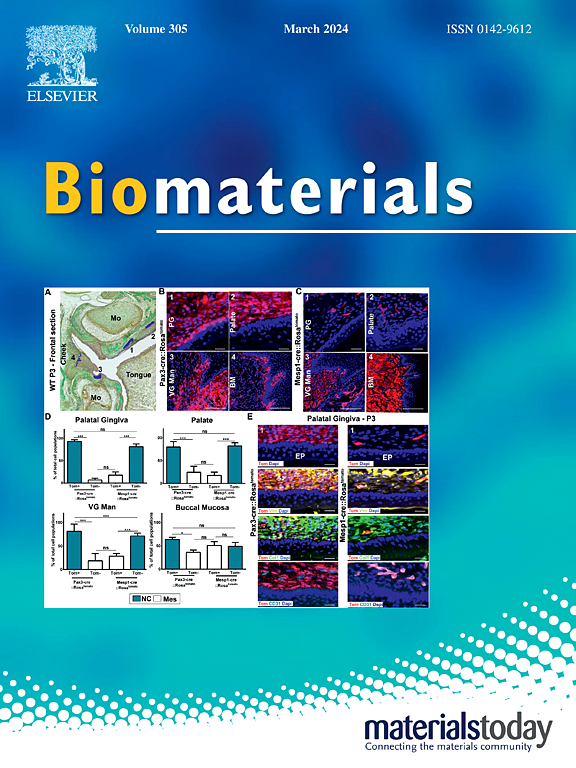Charge-reversal nanoassembly for rheumatoid arthritis therapy via cell-free DNA scavenging and microenvironment reprogramming
IF 12.9
1区 医学
Q1 ENGINEERING, BIOMEDICAL
引用次数: 0
Abstract
The clearance of cell-free DNA (cfDNA) in rheumatoid arthritis (RA) represents a promising therapeutic approach for inflammation. While cationic materials are widely utilized for cfDNA capture, their safety during in vivo delivery remains a critical concern. Additionally, macrophage-mediated inflammatory responses exacerbate disease progression. Here, we propose a charge-reversal and enhanced nanoassembly responsive to the inflammatory microenvironment, composed of a block polymer termed polycaprolactone-poly (N, N-dimethylacrylamide)-thioketal-polyethylene glycol (PCL-PDMA-TK-PEG, PPTP), a copolymer methoxy poly (ethylene glycol)-poly-l-lysine-2,3-dimethylmaleic anhydride (mPEG-PLL-DMA, PLM), and 4-octyl itaconate (4-OI). Charge reversal in acidic inflammatory microenvironments and ROS-responsive enhancement of positive surface charge, significantly improving cfDNA capture efficiency within inflammatory sites. Mitochondrial targeting through electrostatic interactions, promoting 4-OI release to inhibit macrophage-driven inflammation. Reduced protein shielding during systemic circulation, enabling precise accumulation in inflamed joints. The 4-OI@PPTP/PLM nanoassembly effectively suppresses inflammatory cytokine production, mitigates synovial hyperplasia, and attenuates bone erosion in collagen-induced arthritis models. This strategy integrates cfDNA scavenging with microenvironment reprogramming, offering a dual-action therapeutic platform for RA management.
通过无细胞DNA清除和微环境重编程的电荷逆转纳米组装治疗类风湿关节炎
清除类风湿性关节炎(RA)中的游离DNA (cfDNA)是一种很有前途的炎症治疗方法。虽然阳离子材料被广泛用于cfDNA捕获,但它们在体内传递过程中的安全性仍然是一个关键问题。此外,巨噬细胞介导的炎症反应会加剧疾病进展。在这里,我们提出了一种电荷反转和增强的纳米组装对炎症微环境的响应,它由嵌段聚合物聚己内酯-聚(N, N-二甲基丙烯酰胺)-硫酮-聚乙二醇(pcl - pdma - dk - peg, PPTP),甲氧基聚(乙二醇)-聚l-赖氨酸-2,3-二甲基马来酸酐(mPEG-PLL-DMA, PLM)和4-衣康酸辛酯(4-OI)组成。酸性炎症微环境中的电荷反转和ros响应性表面正电荷增强,显著提高炎症部位cfDNA捕获效率。通过静电相互作用靶向线粒体,促进4-OI释放,抑制巨噬细胞驱动的炎症。在体循环过程中减少蛋白质屏蔽,使炎症关节精确积累。在胶原诱导的关节炎模型中,4-OI@PPTP/PLM纳米组件有效地抑制炎症细胞因子的产生,减轻滑膜增生,并减轻骨侵蚀。该策略将cfDNA清除与微环境重编程相结合,为RA管理提供了双重作用的治疗平台。
本文章由计算机程序翻译,如有差异,请以英文原文为准。
求助全文
约1分钟内获得全文
求助全文
来源期刊

Biomaterials
工程技术-材料科学:生物材料
CiteScore
26.00
自引率
2.90%
发文量
565
审稿时长
46 days
期刊介绍:
Biomaterials is an international journal covering the science and clinical application of biomaterials. A biomaterial is now defined as a substance that has been engineered to take a form which, alone or as part of a complex system, is used to direct, by control of interactions with components of living systems, the course of any therapeutic or diagnostic procedure. It is the aim of the journal to provide a peer-reviewed forum for the publication of original papers and authoritative review and opinion papers dealing with the most important issues facing the use of biomaterials in clinical practice. The scope of the journal covers the wide range of physical, biological and chemical sciences that underpin the design of biomaterials and the clinical disciplines in which they are used. These sciences include polymer synthesis and characterization, drug and gene vector design, the biology of the host response, immunology and toxicology and self assembly at the nanoscale. Clinical applications include the therapies of medical technology and regenerative medicine in all clinical disciplines, and diagnostic systems that reply on innovative contrast and sensing agents. The journal is relevant to areas such as cancer diagnosis and therapy, implantable devices, drug delivery systems, gene vectors, bionanotechnology and tissue engineering.
 求助内容:
求助内容: 应助结果提醒方式:
应助结果提醒方式:


